The plant-based feed ingredients market is valued at USD 3,256.8 million in 2025 and is projected to reach USD 5,794.7 million by 2035, advancing at a CAGR of 5.9%. Growth is driven by the expanding animal nutrition sector, rising preference for sustainable protein sources, and the need for enhanced feed efficiency in livestock production environments. Plant-based ingredients offer superior nutritional profiles, reduced environmental impact, and cost-effective protein solutions, making them suitable for livestock feed, poultry operations, aquaculture facilities, and pet food manufacturing.
Oilseeds account for the largest share at 32.0% due to optimal protein content, established supply chains, and compatibility with existing feed formulation systems, while novel proteins and pulses support specialized nutritional applications. Livestock feed represents the dominant application at 45.0% of demand, followed by poultry feed as producers expand protein-efficient feeding programs.
Asia Pacific, particularly India and China, leads growth due to rapid livestock expansion and modernization of animal production systems, while Europe and North America show steady demand supported by established feed manufacturing operations. Competition in the plant-based feed ingredients market remains moderate, with key companies such as ADM, Cargill, and Roquette Frères focusing on processing technology advancement, nutritional optimization, and supply chain reliability to strengthen market positioning.
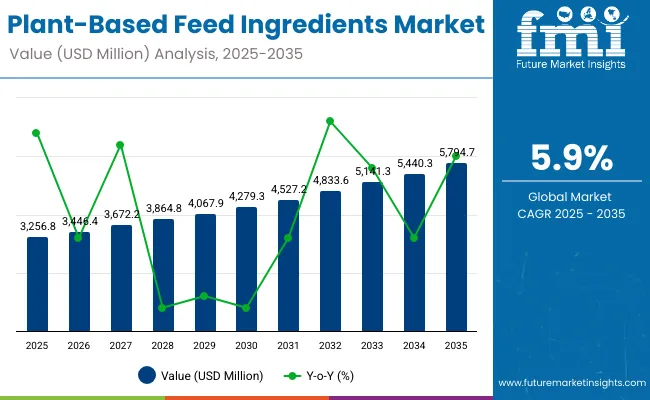
Plant-Based Feed Ingredients Market Key Takeaways
| Metric | Value |
|---|---|
| Estimated Value in (2025E) | USD 3,256.8 million |
| Forecast Value in (2035F) | USD 5,794.7 million |
| Forecast CAGR (2025 to 2035) | 5.9% |
The market dynamics driving plant-based feed ingredients adoption are fundamentally shaped by escalating protein demand in animal production, regulatory pressures for feed safety standards, and the animal nutrition industry's transformation toward precision feeding methodologies. Climate variability has intensified feed cost volatility and protein source availability challenges across major livestock regions, compelling producers and feed manufacturers to implement more diversified ingredient strategies. Simultaneously, government regulations and feed quality standards in many jurisdictions increasingly incentivize nutritional efficiency through performance-based formulations, usage guidelines, and quality mandates that make advanced plant-based ingredients economically attractive investments.
Technological advancement in processing infrastructure, extraction technology, and nutritional testing platforms has dramatically enhanced the capabilities and accessibility of plant-based feed ingredient systems. Modern processing leverages protein isolation, fiber modification, and bioactive compound extraction to provide enhanced nutritional profiles and digestibility characteristics from plant materials, enabling immediate response to changing nutritional requirements and proactive feed management. The integration of analytical testing data, nutritional modeling, amino acid profiling, and digestibility calculations enables these ingredients to optimize feed formulations based on actual animal performance needs rather than predetermined compositions, resulting in significant feed efficiency improvements and improved production outcomes.
The animal production sector's increasing adoption of precision nutrition technologies has created substantial demand for specialized feed ingredient solutions that complement existing feed management systems. Plant-based feed ingredients now interface seamlessly with feed formulation software, enabling comprehensive nutritional analysis and evaluation that supports broader production decision-making processes. This integration capability has proven particularly valuable for large-scale commercial animal operations where coordinated management of multiple species and production stages requires sophisticated nutritional control and monitoring capabilities.
Between 2025 and 2030, the plant-based feed ingredients market is projected to expand from USD 3,256.8 million to USD 4,279.3 million, resulting in a value increase of USD 1,022.5 million, which represents 40.3% of the total forecast growth for the decade. This phase of development will be shaped by rising demand for protein-efficient feed systems, increasing applications in precision animal nutrition and performance feeding technologies, and growing penetration in emerging livestock production markets. Feed ingredient manufacturers are expanding their production capabilities to address the growing demand for customized plant-based ingredients in various animal nutrition segments and feed formulation programs.
From 2030 to 2035, the market is forecast to grow from USD 4,279.3 million to USD 5,794.7 million, adding another USD 1,515.4 million, which constitutes 59.7% of the overall ten-year expansion. This period is expected to be characterized by the expansion of advanced processing infrastructure, the integration of cutting-edge extraction technologies, and the development of customized ingredient systems for specific animal nutrition applications. The growing adoption of precision feeding standards and animal production automation will drive demand for ultra-high efficiency plant-based feed ingredients with enhanced nutritional specifications and consistent performance characteristics.
Between 2020 and 2025, the plant-based feed ingredients market experienced steady expansion, driven by increasing recognition of alternative protein sources' importance in animal nutrition operations and growing acceptance of plant-based feeding systems in complex livestock markets. The market developed as producers recognized the need for high-efficiency nutritional systems to address animal performance requirements and improve overall production productivity. Research and development activities have begun to emphasize the importance of advanced processing technologies in achieving better nutritional efficiency and performance in feeding processes.
Market expansion is being supported by the increasing demand for protein-efficient feed infrastructure and the corresponding need for high-quality plant-based ingredient systems in animal nutrition applications across global livestock, poultry, and aquaculture operations. Modern animal producers are increasingly focused on advanced feeding technologies that can improve nutritional efficiency, reduce protein costs, and enhance production performance while meeting stringent quality requirements. The proven efficacy of plant-based feed ingredients in various animal nutrition applications makes them an essential component of comprehensive feed strategies and production optimization programs.
The growing emphasis on precision animal nutrition and advanced feed optimization is driving demand for ultra-efficient plant-based ingredient systems that meet stringent performance specifications and nutritional requirements for specialized applications. Animal producers' preference for reliable, high-performance feeding systems that can ensure consistent nutritional delivery is creating opportunities for innovative processing technologies and customized nutrition solutions. The rising influence of feed efficiency protocols and production optimization standards is also contributing to increased adoption of premium-grade plant-based feed ingredients across different animal nutrition applications and feeding systems requiring advanced nutritional technology.
| Key Insight | Description |
|---|---|
| Economic advantages of plant-based feed ingredients | Independent, non-commercial institutions consistently highlight the economic benefits of plant-based feed ingredients, especially their strong cost-per-nutrient performance and formulation stability. |
| High nutrient density & lower volatility | Plant-derived proteins such as soybean meal, oilseed cakes, and legume concentrates provide high nutrient density and exhibit lower price and supply volatility than many animal-based alternatives, helping feed manufacturers maintain stable formulation costs. |
| Stable global supply chains | Global outlook assessments emphasize that broad, diversified crop supply chains reduce price fluctuations and support more predictable feed production economics. |
| Competitive cost per unit of digestible protein | Agricultural analyses show that soybean meal delivers one of the most competitive costs per unit of digestible protein, enhancing margin stability across livestock and poultry diets. |
The market is segmented by ingredient type, animal type, functionality, form, product claim, distribution channel, and region. By ingredient type, the market is divided into oilseeds, pulses & legumes, cereals & by-products, fiber sources, novel proteins, by-products, and oil & fat sources. Based on animal type, the market is categorized into livestock feed, poultry feed, aquafeed, pet food, and equine feed. By functionality, the market is divided into protein-rich ingredients, energy sources, fiber enhancers, functional additives, and palatants & flavor enhancers.
By form, the market is divided into pellet, powder, crumble, cake, and liquid extracts. Based on product claim, the market is categorized into non-GMO, organic, antibiotic-free, sustainable sourcing, and upcycled ingredients. By distribution channel, the market is divided into feed manufacturers, ingredient distributors, direct to farms, and online B2B platforms. Regionally, the market is divided into North America, Europe, East Asia, South Asia & Pacific, Latin America, and Middle East & Africa.
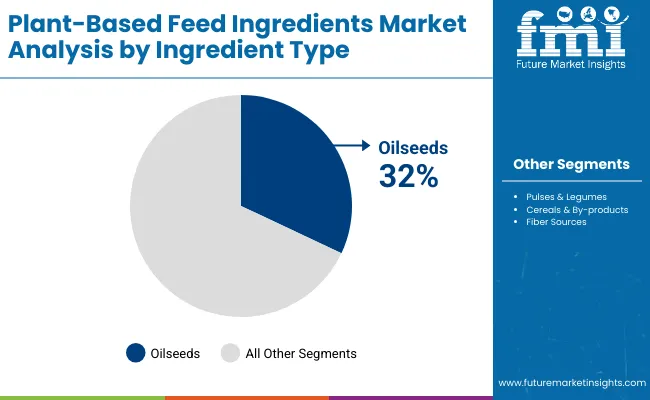
The oilseeds segment is projected to account for 32% of the plant-based feed ingredients market in 2025, reaffirming its position as the category's dominant ingredient type. Animal nutrition specialists increasingly recognize the optimal balance of protein content and nutritional reliability offered by oilseed ingredients for most feeding applications, particularly in livestock production and animal nutrition processes. This ingredient type addresses both protein requirements and long-term nutritional considerations while providing reliable nutrition across diverse animal production applications.
This ingredient type forms the foundation of most animal nutrition protocols for feeding applications, as it represents the most widely accepted and commercially viable level of protein technology in the industry. Nutritional standards and extensive feeding testing continue to strengthen confidence in oilseed ingredient formulations among livestock and animal nutrition providers. With increasing recognition of the protein-nutrition optimization requirements in feed management, oilseed systems align with both operational efficiency and nutritional goals, making them the central growth driver of comprehensive animal production infrastructure strategies.
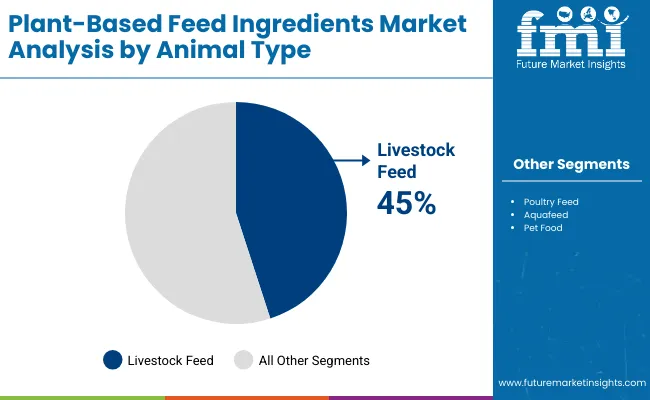
Livestock feed is projected to represent 45% of plant-based feed ingredients demand in 2025, underscoring its role as the primary application segment driving market adoption and growth. Producers recognize that livestock feeding requirements, including complex production operations, specialized nutritional needs, and multi-stage feeding systems, often require advanced plant-based feed ingredients that standard nutrition technologies cannot adequately provide. Plant-based feed ingredients offer enhanced nutritional management and operational compliance in livestock feeding applications.
The segment is supported by the growing complexity of livestock operations, requiring sophisticated nutritional systems, and the increasing recognition that advanced feed technologies can improve animal production performance and operational outcomes. Additionally, producers are increasingly adopting evidence-based feeding guidelines that recommend specific plant-based feed ingredients for optimal nutritional efficiency. As understanding of livestock nutrition advances and feeding requirements become more stringent, plant-based feed ingredients will continue to play a crucial role in comprehensive nutritional strategies within the livestock market.

Protein-rich ingredients are projected to represent 40% of plant-based feed ingredients demand in 2025, demonstrating their critical role as the primary functionality segment driving market expansion and adoption. Animal nutrition specialists recognize that protein requirements, including complex amino acid profiles, specialized digestibility needs, and multi-level protein systems, often require advanced plant-based ingredients that standard protein technologies cannot adequately provide. Protein-focused ingredients offer enhanced nutritional management and operational compliance in animal feeding applications.
The segment is supported by the growing complexity of animal production operations requiring high-quality amino acid delivery and the increasing recognition that protein-rich plant ingredients can significantly improve feed conversion ratios and production outcomes. Modern livestock and poultry operations increasingly focus on balanced amino acid profiles rather than crude protein levels, creating demand for specialized plant-based ingredients that provide essential amino acids such as lysine, methionine, and threonine. These ingredients enable precision protein nutrition strategies that optimize animal growth performance while reducing nitrogen waste and environmental impact.
The plant-based feed ingredients market is advancing steadily due to increasing recognition of alternative protein technologies' importance and growing demand for high-efficiency nutritional systems across the animal production and feed manufacturing sectors. However, the market faces challenges, including complex processing requirements, potential for nutritional variations during production and storage, and concerns about supply chain consistency for specialized plant-based ingredients and the associated processing equipment. Innovation in processing technologies and customized nutrition protocols continues to influence product development and market expansion patterns.
The growing adoption of advanced animal production facilities is enabling the development of more sophisticated plant-based feed ingredients production and performance control systems that can meet stringent operational requirements. Specialized animal production facilities offer comprehensive feeding services, including advanced nutritional control and monitoring processes that are particularly important for achieving high-efficiency requirements in animal applications. Advanced animal production infrastructure provides access to premium services that can optimize feeding performance and reduce nutritional costs while maintaining cost-effectiveness for large-scale livestock operations.
Modern animal production organizations are incorporating digital technologies such as real-time performance monitoring, automated feeding systems, and production integration to enhance plant-based feed ingredients deployment and distribution processes. These technologies improve nutritional performance, enable continuous operational monitoring, and provide better coordination between producers and animal nutrition specialists throughout the feeding cycle. Advanced digital platforms also enable customized performance specifications and early identification of potential nutritional deviations or supply disruptions, supporting reliable animal production.
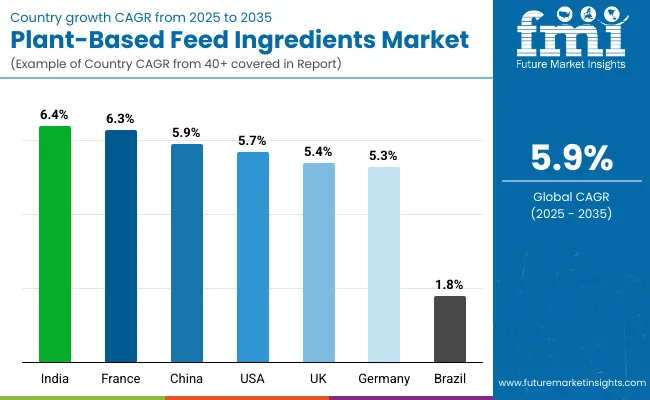
| Countries | CAGR (2025 to 2035) |
|---|---|
| China | 5.9% |
| India | 6.4% |
| Germany | 5.3% |
| France | 6.3% |
| UK | 5.4% |
| USA | 5.7% |
| Brazil | 1.8% |
The plant-based feed ingredients market is experiencing varied growth globally, with India leading at a 6.4% CAGR through 2035, driven by the expansion of livestock infrastructure development, increasing animal production capacity capabilities, and growing domestic demand for high-efficiency feed ingredient systems. France follows at 6.3%, supported by animal production expansion, growing recognition of advanced nutrition technology importance, and expanding livestock capacity.
China records 5.9% growth, with a focus on developing the animal production infrastructure and precision feeding industries. USA shows 5.7% growth, representing an established market with expanding agricultural frameworks. UK demonstrates 5.4% growth with focus on advanced nutrition adoption. Germany demonstrates 5.3% growth, emphasizing livestock infrastructure expansion and systematic feeding approaches.
Revenue from plant-based feed ingredients in China is projected to exhibit steady growth with a CAGR of 5.9% through 2035, driven by ongoing animal production expansion and increasing recognition of high-efficiency nutrition systems as essential feed components for complex livestock processes. The country's expanding animal production infrastructure and growing availability of specialized nutritional capabilities are creating significant opportunities for plant-based feed ingredients adoption across both domestic and export-oriented animal production facilities.
Major international and domestic nutrition companies are establishing comprehensive control and distribution networks to serve the growing population of producers and animal production facilities requiring high-performance feeding systems across nutritional management and animal production applications throughout China's major livestock hubs.
The Chinese government's strategic emphasis on animal production infrastructure modernization and livestock advancement is driving substantial investments in specialized nutritional capabilities. This policy support, combined with the country's large domestic animal production market and expanding feeding requirements, creates a favorable environment for the plant-based feed ingredients market development. Chinese producers are increasingly focusing on high-value nutrition technologies to improve livestock capabilities, with plant-based feed ingredients representing a key component in this animal production transformation.
Government initiatives supporting animal production development and feed modernization are driving demand for high-efficiency nutrition systems throughout major livestock and animal production centers, including northeastern provinces, central plains, and southern agricultural regions. Animal production capacity expansion and nutritional system development are supporting appropriate utilization of plant-based feed ingredients among producers and animal production facilities nationwide, with particular growth in livestock operations and precision feeding services.
Revenue from plant-based feed ingredients in India is expanding at a CAGR of 6.4%, supported by increasing animal production accessibility, growing feed infrastructure awareness, and developing nutrition market presence across the country's major livestock clusters.
The country's large animal production sector and increasing recognition of advanced nutrition systems are driving demand for effective high-efficiency nutritional solutions in both livestock production and animal nutrition applications. International animal production companies and domestic providers are establishing comprehensive distribution channels to serve the growing demand for quality nutrition systems while supporting the country's position as an emerging feed technology market.
India's animal production sector continues to benefit from favorable feeding policies, expanding animal production capabilities, and cost-competitive nutrition infrastructure development. The country's focus on becoming a global animal production technology hub is driving investments in specialized feed technology and nutritional management infrastructure. This development is particularly important for plant-based feed ingredients applications, as producers seek reliable domestic sources for critical nutritional technologies to reduce import dependency and improve supply chain security.
Rising awareness about advanced nutritional options and improving animal production capabilities are creating opportunities for specialized nutrition systems across livestock and animal production settings in major hubs like Punjab, Haryana, and Maharashtra. Growing animal production infrastructure development and technology adoption are supporting increased access to high-efficiency plant-based feed ingredients among organizations requiring comprehensive nutritional capabilities, particularly in livestock production and animal nutrition organizations.
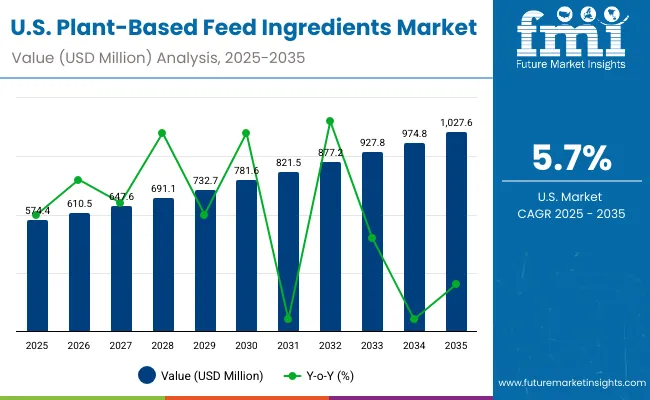
USA's advanced nutrition technology market demonstrates sophisticated animal production infrastructure deployment with documented plant-based feed ingredients effectiveness in livestock departments and animal production centers through integration with existing feeding systems and nutritional infrastructure.
The country leverages animal production expertise in feed technology and nutritional management systems integration to maintain a 5.7% CAGR through 2035. Animal production centers, including major livestock areas, showcase premium installations where plant-based feed ingredients integrate with comprehensive nutritional information systems and control platforms to optimize feeding accuracy and operational workflow effectiveness.
American producers prioritize system reliability and nutritional compliance in infrastructure development, creating demand for premium systems with advanced features, including performance validation and integration with US animal production standards. The market benefits from established livestock industry infrastructure and a willingness to invest in advanced nutrition technologies that provide long-term operational benefits and compliance with feeding regulations.
Germany demonstrates steady market development with a 5.3% CAGR through 2035, distinguished by animal production operators' preference for high-quality nutrition systems that integrate seamlessly with existing livestock equipment and provide reliable long-term operation in specialized animal production applications. The market prioritizes advanced features, including precision nutritional algorithms, performance validation, and integration with comprehensive feeding platforms that reflect German animal production expectations for technological advancement and operational excellence.
Premium focus on precision systems with advanced nutritional algorithms and high-reliability capabilities for animal production applications requiring exceptional performance standards. Integration requirements with existing animal production information systems and nutritional management platforms supporting comprehensive livestock automation. Emphasis on plant-based feed ingredients reliability and long-term performance in livestock applications with strict operational requirements. Strong preference for locally manufactured systems that comply with German engineering standards and animal production regulations.
France demonstrates strong market development with a 6.3% CAGR through 2035, driven by advanced animal production infrastructure and livestock preference for technology-integrated plant-based feed ingredients. The country's sophisticated animal production ecosystem and high automation adoption rates are creating significant opportunities for plant-based feed ingredients adoption across both domestic and technology-driven animal production facilities.
The market expansion benefits from diverse animal production demand, including nutrition infrastructure modernization in major agricultural regions, nutritional development programs, and government animal production programs that increasingly incorporate plant-based feed ingredients solutions for infrastructure enhancement applications.
Market dynamics focus on cost-effective nutrition solutions that balance advanced nutritional features with affordability considerations important to French animal production operators. Growing animal production infrastructure creates demand for modern nutrition systems in new livestock facilities and animal production equipment modernization projects.
Agricultural and livestock infrastructure segments leading growth with focus on nutritional enhancement and operational efficiency applications. Regional feeding requirements are driving a diverse product portfolio from basic nutrition systems to advanced nutritional platforms. Import dependency challenges offset by potential local development partnerships with international nutritional manufacturers. Government animal production initiatives beginning to influence procurement standards and feed infrastructure requirements.
UK demonstrates steady market development with a 5.4% CAGR through 2035, distinguished by livestock operators' preference for high-quality nutrition systems that integrate seamlessly with existing animal production equipment and provide reliable long-term operation in specialized livestock applications. The market prioritizes advanced features, including precision nutritional algorithms, performance validation, and integration with comprehensive feeding platforms that reflect UK animal production expectations for technological advancement and operational excellence.
Strategic emphasis on research and development partnerships between universities, agricultural institutions, and feed companies is accelerating the adoption of novel plant-based ingredients in UK livestock operations. The market demonstrates strong preference for locally sourced ingredients when possible, supporting domestic agricultural diversity and supply chain resilience. UK producers increasingly recognize the importance of feed ingredients that can maintain consistent animal performance across varied environmental conditions while supporting the country's commitment to carbon footprint reduction in agricultural operations.
Brazil demonstrates slower market development with a 1.8% CAGR through 2035, representing emerging opportunities in the country's expanding animal production infrastructure and developing nutrition technology adoption. The market faces challenges related to economic conditions and infrastructure development, but shows potential for growth as livestock operations modernize and adopt advanced feeding technologies.
Economic volatility and currency fluctuations present ongoing challenges for ingredient adoption, particularly for imported technologies and specialized processing equipment required for advanced ingredient production. However, government initiatives supporting agricultural modernization and export competitiveness are gradually improving access to financing for feed technology investments. The market shows increasing recognition of the importance of feed efficiency improvements in maintaining competitiveness in global protein export markets.
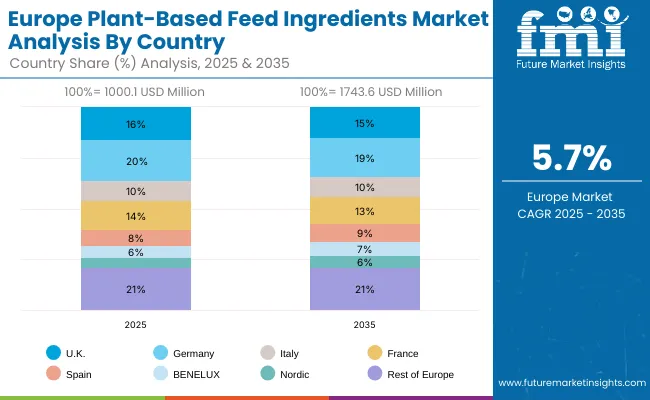
The plant-based feed ingredients market in Europe is projected to grow significantly, with individual country performance varying across the region. Germany is expected to maintain its leadership position with a market value of USD 200.0 million in 2025, supported by its advanced animal production infrastructure, precision nutritional management capabilities, and strong livestock presence throughout major agricultural regions.
UK follows with USD 160.0 million in 2025, driven by advanced nutritional protocols, feed innovation integration, and expanding animal production networks serving both domestic and international markets. France holds USD 140.0 million in 2025, supported by animal production infrastructure expansion and growing adoption of high-efficiency nutrition systems. Italy commands USD 100.0 million in 2025, while Spain accounts for USD 80.0 million in 2025. The Rest of Europe region, excluding Germany, the UK, France, Italy, Spain, Nordic, and BENELUX, holds USD 210.0 million in 2025, covering Eastern Europe and smaller Western European markets.
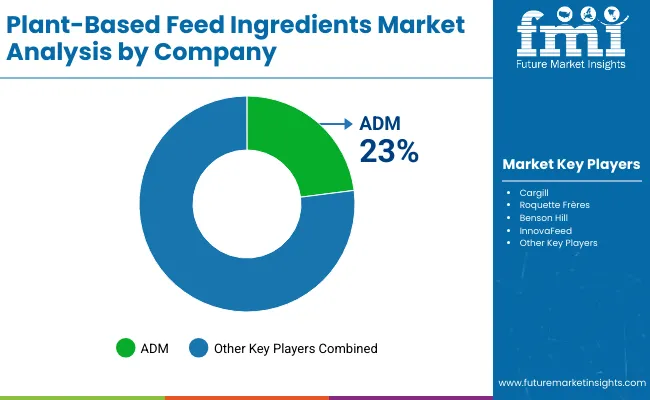
The plant-based feed ingredients market is characterized by competition among established feed ingredient companies, specialty nutrition companies, and animal production technology suppliers focused on delivering high-efficiency, consistent, and reliable nutritional systems. Companies are investing in processing technology advancement, nutritional enhancement, strategic partnerships, and customer technical support to deliver effective, efficient, and reliable nutrition solutions that meet stringent livestock and animal production requirements. Nutritional optimization, performance validation protocols, and supply chain strategies are central to strengthening product portfolios and market presence.
ADM leads the market with a 23.0% market share, offering comprehensive high-efficiency plant-based feed ingredients with a focus on nutritional consistency and ingredient reliability for animal production applications. Cargill provides specialized nutritional systems with emphasis on livestock applications and comprehensive technical support services. Roquette Frères focuses on advanced processing technologies and customized animal production solutions for nutritional systems serving global markets. Benson Hill delivers established nutrition solutions with strong performance outcomes and robust customer service capabilities.
InnovaFeed operates with a focus on bringing innovative nutrition technologies to specialized animal production applications and emerging markets. Companies provide comprehensive nutritional system portfolios, including advanced feeding services, across multiple animal production applications and nutritional management processes. Specialty providers focus on customized nutritional solutions and performance management systems for animal production systems with emphasis on feeding compliance. Established suppliers provide reliable supply chain solutions and technical expertise to enhance market accessibility and customer access to essential nutrition systems.
| Items | Values |
|---|---|
| Quantitative Units (2025) | USD 3,256.8 Million |
| Ingredient Type | Oilseeds, Pulses & Legumes, Cereals & By-products, Fiber Sources, Novel Proteins, By-products, Oil & Fat Sources |
| Animal Type | Livestock Feed, Poultry Feed, Aquafeed, Pet Food, Equine Feed |
| Functionality | Protein-Rich Ingredients, Energy Sources, Fiber Enhancers, Functional Additives, Palatants & Flavor Enhancers |
| Form | Pellet, Powder, Crumble, Cake, Liquid Extracts |
| Product Claim | Non-GMO, Organic, Antibiotic-Free, Sustainable Sourcing, Upcycled Ingredient |
| Distribution Channel | Feed Manufacturers, Ingredient Distributors, Direct to Farms, Online B2B Platforms |
| Regions Covered | North America, Europe, East Asia, South Asia & Pacific, Latin America, Middle East & Africa |
| Countries Covered | China, USA, Germany, Japan, India, France, UK, Brazil and 40+ countries |
| Key Companies Profiled | ADM, Cargill, Roquette Frères, Benson Hill, and InnovaFeed |
| Additional Attributes | Dollar sales by ingredient type and animal type, regional demand trends, competitive landscape, producer preferences for specific nutrition systems, integration with specialty animal production supply chains, innovations in processing technologies, performance monitoring, and nutritional optimization |
The market is valued at USD 3,256.8 million in 2025.
It is projected to reach USD 5,794.7 million by 2035.
The market will expand at a 5.9% CAGR over the forecast period.
Oilseeds lead the market with a 32% share.
Livestock feed accounts for 45% of total demand in 2025.






Our Research Products

The "Full Research Suite" delivers actionable market intel, deep dives on markets or technologies, so clients act faster, cut risk, and unlock growth.

The Leaderboard benchmarks and ranks top vendors, classifying them as Established Leaders, Leading Challengers, or Disruptors & Challengers.

Locates where complements amplify value and substitutes erode it, forecasting net impact by horizon

We deliver granular, decision-grade intel: market sizing, 5-year forecasts, pricing, adoption, usage, revenue, and operational KPIs—plus competitor tracking, regulation, and value chains—across 60 countries broadly.

Spot the shifts before they hit your P&L. We track inflection points, adoption curves, pricing moves, and ecosystem plays to show where demand is heading, why it is changing, and what to do next across high-growth markets and disruptive tech

Real-time reads of user behavior. We track shifting priorities, perceptions of today’s and next-gen services, and provider experience, then pace how fast tech moves from trial to adoption, blending buyer, consumer, and channel inputs with social signals (#WhySwitch, #UX).

Partner with our analyst team to build a custom report designed around your business priorities. From analysing market trends to assessing competitors or crafting bespoke datasets, we tailor insights to your needs.
Supplier Intelligence
Discovery & Profiling
Capacity & Footprint
Performance & Risk
Compliance & Governance
Commercial Readiness
Who Supplies Whom
Scorecards & Shortlists
Playbooks & Docs
Category Intelligence
Definition & Scope
Demand & Use Cases
Cost Drivers
Market Structure
Supply Chain Map
Trade & Policy
Operating Norms
Deliverables
Buyer Intelligence
Account Basics
Spend & Scope
Procurement Model
Vendor Requirements
Terms & Policies
Entry Strategy
Pain Points & Triggers
Outputs
Pricing Analysis
Benchmarks
Trends
Should-Cost
Indexation
Landed Cost
Commercial Terms
Deliverables
Brand Analysis
Positioning & Value Prop
Share & Presence
Customer Evidence
Go-to-Market
Digital & Reputation
Compliance & Trust
KPIs & Gaps
Outputs
Full Research Suite comprises of:
Market outlook & trends analysis
Interviews & case studies
Strategic recommendations
Vendor profiles & capabilities analysis
5-year forecasts
8 regions and 60+ country-level data splits
Market segment data splits
12 months of continuous data updates
DELIVERED AS:
PDF EXCEL ONLINE
Fish Feed Ingredients Market Analysis - Size, Share, and Forecast Outlook 2025 to 2035
Animal Feed Ingredients Market Analysis - Size, Share, & Forecast Outlook 2025 to 2035
USA Animal Feed Ingredients Market Report – Trends & Innovations 2025-2035
Nutritional Ingredients in Animal Feed Market Trends - Growth & Industry Forecast 2025 to 2035
Feed Mixer for Livestock Market Size and Share Forecast Outlook 2025 to 2035
Feed Preparation Machine Market Size and Share Forecast Outlook 2025 to 2035
Feed Additive Nosiheptide Premix Market Size and Share Forecast Outlook 2025 to 2035
Feeder Container Market Size and Share Forecast Outlook 2025 to 2035
Feed Machine Market Forecast Outlook 2025 to 2035
Feed Pigment Market Forecast and Outlook 2025 to 2035
Feed Mixer Market Forecast and Outlook 2025 to 2035
Feed Grade Spray-dried Animal Plasma (SDAP) Market Size and Share Forecast Outlook 2025 to 2035
Feed Electrolytes Market Size and Share Forecast Outlook 2025 to 2035
Feed Micronutrients Market Size and Share Forecast Outlook 2025 to 2035
Ingredients Market for Plant-based Food & Beverages Size and Share Forecast Outlook 2025 to 2035
Feed Acidifier Market Analysis Size Share and Forecast Outlook 2025 to 2035
Feed Flavors Market Size and Share Forecast Outlook 2025 to 2035
Feed Enzymes Market Analysis - Size, Share, and Forecast Outlook 2025 to 2035
Feed Mycotoxin Binders Market Size and Share Forecast Outlook 2025 to 2035
Feed Phytogenics Market Size and Share Forecast Outlook 2025 to 2035

Thank you!
You will receive an email from our Business Development Manager. Please be sure to check your SPAM/JUNK folder too.
Chat With
MaRIA